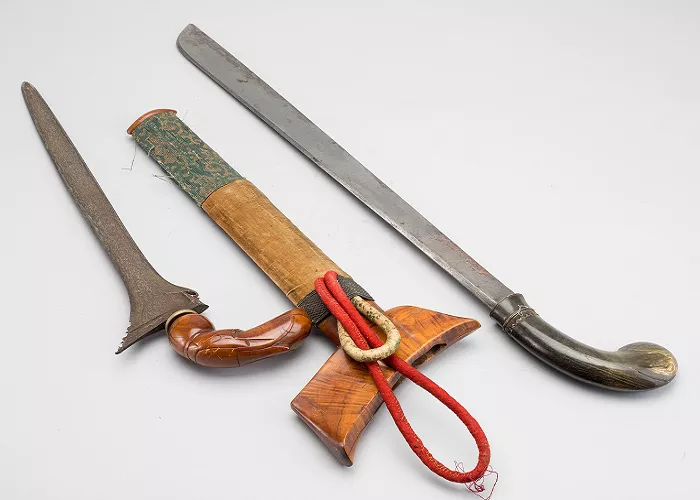At Czerny’s International Auction House in Sarzana, Italy, a rare Indonesian kris dagger set a new record in mid-December, selling for €99,025—far exceeding its €8,000 estimate. The high-quality 16th-century dagger, featuring a straight blade adorned with gold lotus-style decorations and a rare Javanese tunggak semi hilt, generated intense bidding, with the eventual winner speculated to be from Indonesia, where such items can command even higher prices. The dagger is believed to carry Tantric-Shivaite power, enhancing its historical and cultural value.
The market for antique Asian weaponry has seen a significant surge in recent years, growing faster than antique weaponry from any other region. The rise of economic powers in Asia, coupled with an increasing interest in countries like India and China, has fueled global demand for swords, daggers, shields, and armor. These items, originally designed for battle, were often commissioned by royalty and elites as status symbols, making them highly prized by collectors.
One of the foremost experts in the field, Runjeet Singh, a Warwickshire-based dealer and specialist in Asian, particularly South Asian, weaponry, has become a prominent figure in this thriving market. Singh, who grew up in Birmingham and later joined the West Midlands police force, discovered antique weapons through his practice of Sikh martial arts. In 1999, he purchased his first sword—a modest £50 Indian tulwar—at a Birmingham arms fair. The experience sparked a lifelong passion for collecting and studying weapons, which led Singh to transition from law enforcement to a full-time dealer in 2014. By 2021, Singh’s expertise earned him a spot on the popular BBC show Antiques Roadshow as the Asian weaponry expert.
Singh’s keen eye for value has led to significant discoveries. In his first Antiques Roadshow appearance, he evaluated a collection of daggers acquired by a collector for £10,000, estimating their value at £80,000 to £100,000—a clear indication of the escalating market for such artifacts. Singh attributes the growth of interest in Indian weaponry to second-generation South Asians in Europe and America, while a rising trend of wealthy Indonesians purchasing kris daggers to reclaim their heritage has further fueled demand for these unique items.
Singh’s approach to collecting is driven by a desire to uncover new pieces and learn about their history. His home reflects this approach, housing a carefully curated selection of antiques, including many related to his ancestral India, but also showcasing a broader range of Asian items, each with its own intriguing story.
In addition to rare weaponry, Singh has made notable sales of unique objects. One of his recent acquisitions was a 19th-century taus, a four-stringed lute in the shape of a peacock, which he found after a lengthy search. He also presented an extremely rare 18th-century bagh-nakh (a “leopard claw” weapon) at the 2022 European Fine Art Foundation (TEFAF) show in Maastricht, where it quickly sold for a five-figure sum.
The demand for such items has led to fierce competition in auctions and antique fairs, especially at events like TEFAF and London’s Asian Art Week. The market has also expanded beyond in-person auctions, with many collectors now making purchases based solely on images posted on Singh’s website. Despite the shift toward online sales, Singh emphasizes the importance of experience and study in identifying valuable pieces, noting that an increasing number of rare objects are now being offered to him directly.
Singh’s work spans the globe, consulting for private clients and sourcing rare pieces for those with specific interests. While celebrities, such as Tom Selleck and Angelina Jolie, are known to collect antique weapons, most high-profile collectors prefer to remain anonymous. Recently, the French auction house Giquello sold the collection of the late author Philippe Missillier, which included both European and Asian weaponry. The auction raised approximately €7.5 million, with €2.35 million attributed to Islamic and Indian pieces—a testament to the growing value of such artifacts.
Singh’s involvement in the auction market has also given him insight into the secrecy surrounding many sales. As much as 50% of the market remains hidden, with rare pieces often kept out of the public eye in private collections. This mystery makes the public appearance of high-value items like the kris dagger all the more significant.
However, as demand rises, so does the prevalence of forgeries. Experts like Singh emphasize that the key to avoiding counterfeit items is education. He advises aspiring collectors to visit museums, attend fairs, and consult dealers to develop the expertise needed to identify genuine pieces. Notable collections such as the Wallace Collection in London, the Stibbert Collection in Florence, and the Victoria and Albert Museum’s Great Mughals exhibition offer invaluable opportunities to study authentic artifacts, helping to cultivate the expertise needed to navigate the market.
In an industry marked by mystery and the occasional clandestine sale, the rising interest in antique Asian weaponry is transforming it into a major collecting field. As demand continues to grow, it seems clear that these exceptional objects will remain a prized part of both historical study and the global art market.

